(Special thanks to Chuck Granata, of course, and to Michael “Contentious” Kraus and Rob Waldman for reading this through in advance. And as always to Elizabeth Zimmer!)
Continued - part 3 of now 4 (this was to be the conclusion, but I’ve received enough reactions and additional material to make for a part four. (“Sounds like pure soap opera.” “I may cry.” “Tune in tomorrow!”)
“Rag Mop” (duet with Dagmar) (Johnnie Lee Wills & Deacon Anderson)
Okay, it’s a dumb novelty number - a lot of us grew up with “Rag Mop” on the Beany and Cecil cartoon show - but the song has a storied history that encompasses a lot of mid-century American music. The term “mop” appears many times in the jazz canon, as in “Jumping with the Mop” by the King Cole Trio in 1941 while Louis Armstrong regularly played a tune called “Mop Mop” from 1944 onwards. This song started as a riff by pioneering New Orleans trumpeter Red Allen, who called it “Get the Mop,” and then was adapted into a western swing number by Oklahoma bandleader Johnnie Lee Wills and Deacon Anderson, and from there it was reclaimed by swing bands who played it in an early R&B style, most famously Lionel Hampton and Ralph Flanagan. The song was widely recorded in all three genres in 1950: rhythm & blues groups, country & western, jazz and swing bands - but the version that most people remember, other than Beany and Cecil, is by the Ames Brothers (1950).
Because of “Mama Will Bark,” Sinatra fans have traditionally been disparaging of Dagmar, the stage name of Virginia Ruth "Jennie" Lewis (née Egnor) (1921-2001) but she was a very funny comedienne in her day, and her use of her body form in her humor could even be argued was a foreshadowing of proto-feminist humor. She appeared on several episodes of The Frank Sinatra Show on CBS in April and May 1950, and was briefly almost a semi-regular. As this track shows, Frank and Dagmar were indeed funny and even charming together; the skinniest male heartthrob in history, and a zaftig, larger than life lady comic - built, as Louis Prima might say, like a brick pizza oven. She was savaging the stacked, dumb-blonde stereotype well before the rise of Marilyn Monroe or Jayne Mansfield.
“Rag Mop” was a dopey novelty song of the kind that Sinatra famously dismissed consistently throughout his career - as in his 1948 Metronome interview with George Simon - but isn’t any worse than many of the songs he did record in this period, like “Bim Bam Baby” and “Tennessee Newsboy.”
The song also speaks to the continued presence of Sammy Cahn in Sinatra’s life. Many years later, Sammy made it a point to tell Chuck Granata and myself, along with many other interviewers, that he stuck by Sinatra’s side through thick and thin, this being a clear instance moment of the latter. The “special lyrics” as Sammy called them (he hated the word “parody”) are clearly Sammy’s work. Between the two of them, they take a rather left- field idea - Sinatra doing an unlikely song with an unlikely partner - and kind of make it work. Early in the song, they spell out the Italian exclamation, marone - it’s a slang curse word referring to the male sex organ, but like certain Yiddish words with sexual connotations, some entertainers were able to get away with it, even in these button-downed times. They then spell out each other’s names, trading affectionate quips along the way in rewritten lyrics:
He sings:
You’re an exquisite flower,
Built like the Eiffel Tower.
Prettier by the hour,
You better turn off your power.
You’d frighten Eisenhower.
She responds:
You’re such a little sinner.
You know you’re no beginner.
You couldn’t be much thinner.
What did you eat for dinner? (He responds, in tempo, “salsiccia” - Italian sausage)
You got some on your chin-ner. (At least, I think that’s what she says.)
This is the sleeper surprise of the show; Mitch Miller always said that it was Sinatra’s own idea for him to do a duet with Dagmar for Columbia. Alas, Mitch picked a dog of a tune - literally - that was beyond saving. At no point - unlike “Would I Love You” - does he act like “Rag Mop” is beneath him. As the house applauds and we hear the band start in on the next tune, we hear him say, “Thank you, sweetie!” to Dagmar.
“My Blue Heaven” (Walter Donaldson-George A. Whiting) and show close.
“My Blue Heaven” was one the earth-shattering mega hits of Sinatra’s youth; as crooned by Gene Austin, it was one of the biggest-selling records in the history of the medium, and a song that anybody who had been listening to popular music in the 1920s would have known. Sinatra and George Siravo patterned their arrangement, for the 1950 Sing and Dance album, on that by Sy Oliver for Jimmie Lunceford’s Orchestra in 1935. (A love of Lunceford was another trait that Sinatra shared with Nat Cole.) Oliver uses more of a shuffle beat, but Sinatra’s phrasing is, overall, highly inspired by the Lunceford vocal trio, especially the way in which they momentarily shift tempos and go into something like an a capella cadenza on the line, “a nest that nestles where the roses bloom!” (Sinatra also quotes Lunceford on his 1953 recording of the 1923 show tune “I Love You.”) Again the vocal is more sure-footed and confident than the 1950 studio version.
Alas, Bill Smith of Billboard (“Dagmar’s Chest Gives Big Lift to Sinatra’s Return to Para,” May 5, 1951), who seemed to think that Dagmar was stealing the show from Sinatra, observed, “When Sinatra started his last number, right after Dagmar walked off, the audience began moving out.” Smith also noted, “Sinatra is too good a showman not to see this for himself.”
We hear the bow music - which turns out to be “Oh! Look at Me Now,” from the joint past of both Sinatra and Bushkin. We also hear both the French announcer - in the studio after the fact - as well as an American announcer, in the Paramount at the moment. (He doesn’t introduce himself, but it sounds like the voice of Joe Bushkin.) The entire performance lasts barely 20 minutes, but that was what the major stars of these movie-vaudeville stage shows were allotted - more customarily, lesser known acts were only given eight or nine minutes in the vaudeville tradition. Alas, these are 20 very major moments in the artistic development of the century’s greatest singer and showman - and maybe someday they’ll be properly released for everybody to hear and enjoy.

Sing! Sing! Sing! : My tagline is, “Celebrating the great jazz - and jazz-adjacent - singers, as well as the composers, lyricists, arrangers, soloists, and sidemen, who help to make them great.”
A production of KSDS heard Saturdays at 10:00 AM Pacific; 1:00PM Eastern.
To listen to KSDS via the internet (current and recent shows are available for streaming.) click here.
The whole series is also listenable on Podbean.com, click here.
December 1: The Early Years 1935-42 hosted by Will Friedwald
December 4: The Columbia Years 1943-’49 hosted by Ken Poston
December 5: The Radio Years: hosted by Chuck Granata
December 6: The Fall and Rise (1950-’54) hosted by Will Friedwald
December 7: Frank and Nelson hosted by Will Friedwald
December 8: The Capitol Years hosted by Loren Schoenberg
December 9: Bonus! Sing! Sing! Sing! Some Frank Conversation with Adam Gopnik
December 11: The Movies: Hosted by Chuck Granata
December 12: The Early Reprise Years 1960-'65 hosted by Loren Schoenberg
December 13:The Concert Years hosted by Ken Poston
December 14: The Rat Pack hosted by Ken Poston
December 15: Inside the Studio hosted by Chuck Granata
December 16: Bonus! In the Wee Small Hours with AJ Lambert (Sinatra’s granddaughter)
December 18: 1965-1974 The Main Event hosted by Will Friedwald
Disclaimer: These are my memories of these incidents, nothing more, nothing less. I apologize in advance in case they may not line up precisely with anyone else’s account of what transpired on those occasions.
Very Special thanks to the fabulous Ms. Elizabeth Zimmer, for expert proofreading of this page, and scanning for typos, mistakes, and other assorted boo-boos!
Sing! Sing! Sing! : My tagline is, “Celebrating the great jazz - and jazz-adjacent - singers, as well as the composers, lyricists, arrangers, soloists, and sidemen, who help to make them great.”
A production of KSDS heard Saturdays at 10:00 AM Pacific; 1:00PM Eastern.
To listen to KSDS via the internet (current and recent shows are available for streaming.) click here.
The whole series is also listenable on Podbean.com, click here.
December 1: The Early Years 1935-42 hosted by Will Friedwald
December 4: The Columbia Years 1943-’49 hosted by Ken Poston
December 5: The Radio Years: hosted by Chuck Granata
December 6: The Fall and Rise (1950-’54) hosted by Will Friedwald
December 7: Frank and Nelson hosted by Will Friedwald
December 8: The Capitol Years hosted by Loren Schoenberg
December 9: Bonus! Sing! Sing! Sing! Some Frank Conversation with Adam Gopnik
December 11: The Movies: Hosted by Chuck Granata
December 12: The Early Reprise Years 1960-'65 hosted by Loren Schoenberg
December 13:The Concert Years hosted by Ken Poston
December 14: The Rat Pack hosted by Ken Poston
December 15: Inside the Studio hosted by Chuck Granata
December 18: 1965-1974 The Main Event hosted by Will Friedwald
SLOUCHING TOWARDS BIRDLAND is a subStack newsletter by Will Friedwald. The best way to support my work is with a paid subscription, for which I am asking either $5 a month or $50 per year. Thank you for considering. (Thanks as always to Beth Naji & Arlen Schumer for special graphics.) Word up, peace out, go forth and sin no more! (And always remember: “A man is born, but he’s no good no how, without a song.”)
Note to friends: a lot of you respond to my SubStack posts here directly to me via eMail. It’s actually a lot more beneficial to me if you go to the SubStack web page and put your responses down as a “comment.” This helps me “drive traffic” and all that other social media stuff. If you look a tiny bit down from this text, you will see three buttons, one of which is “comment.” Just hit that one, hey. Thanks!


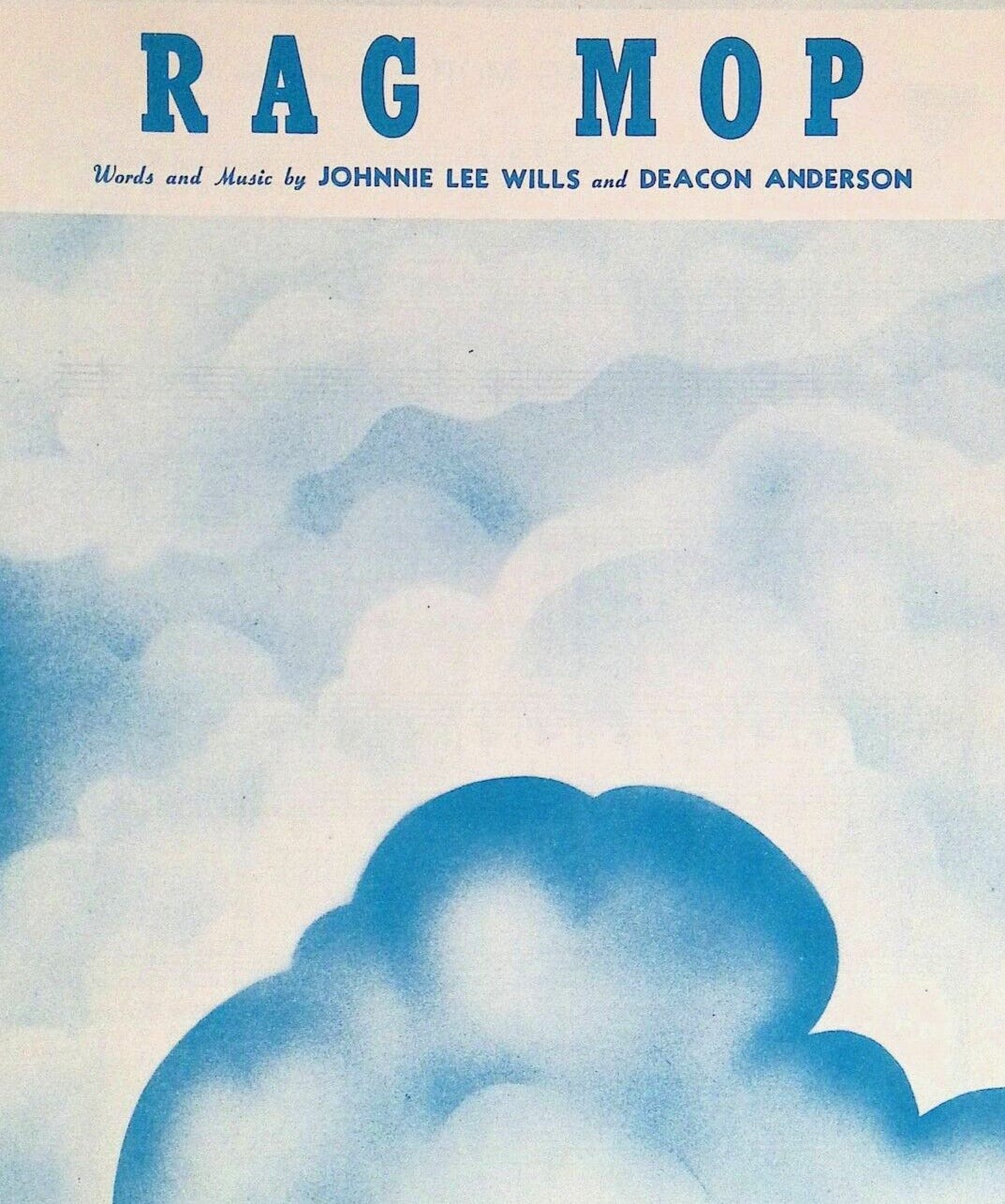
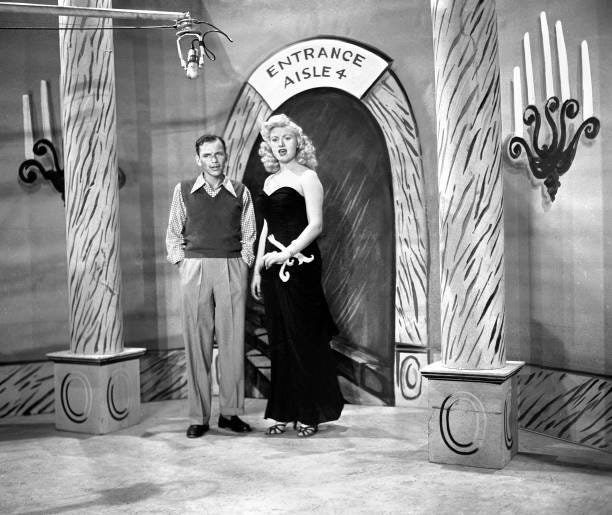
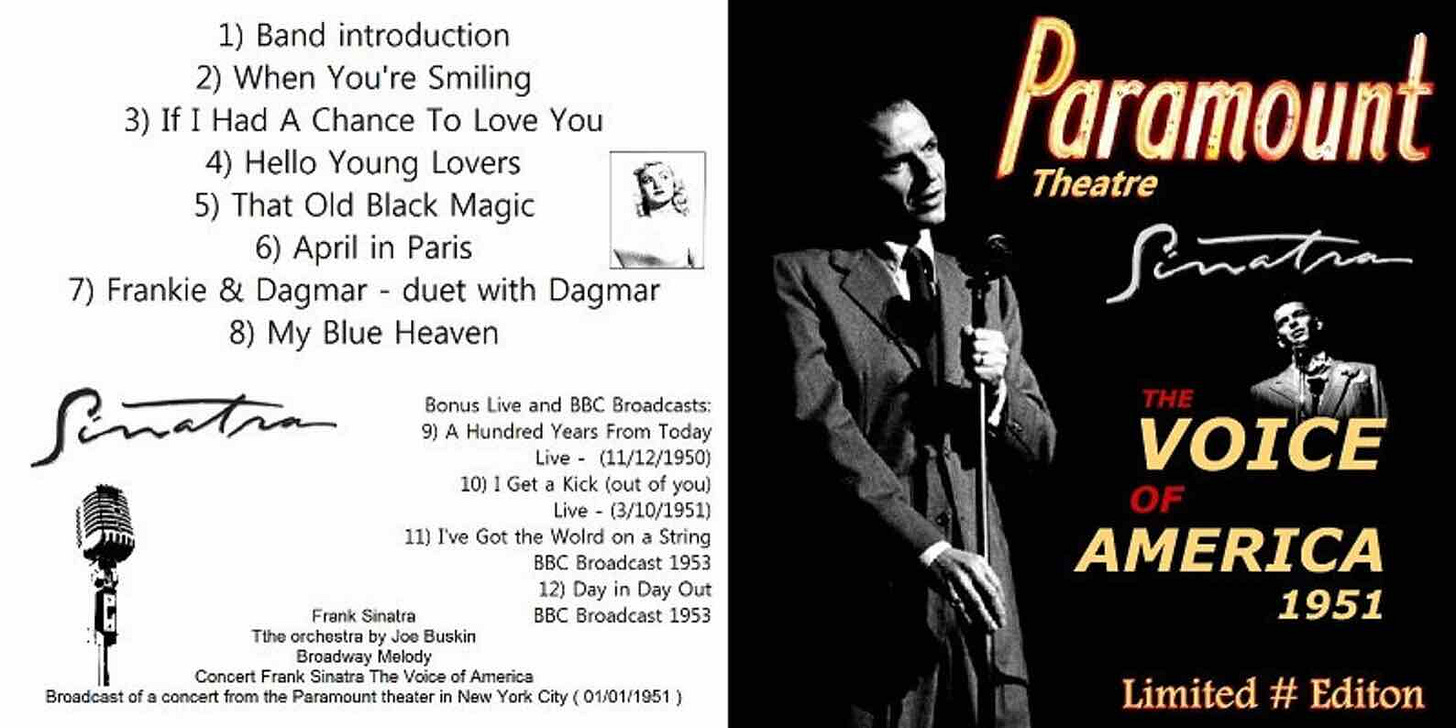
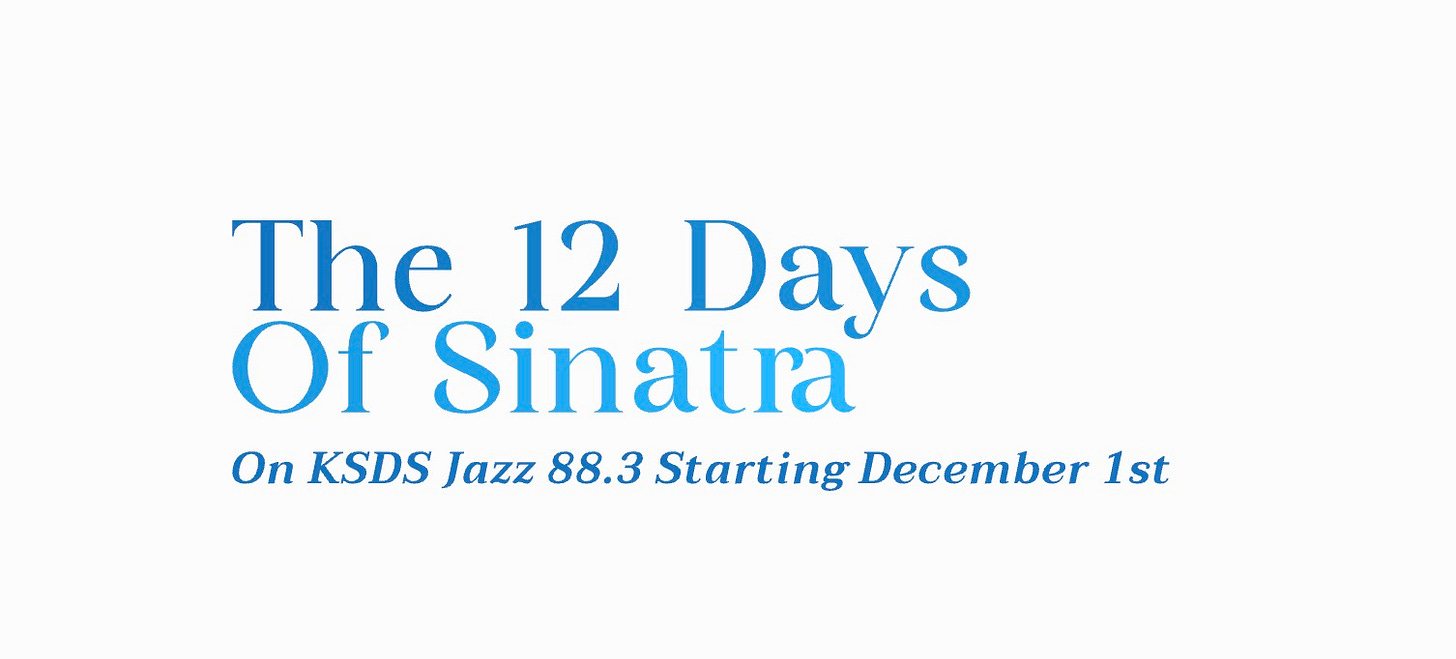
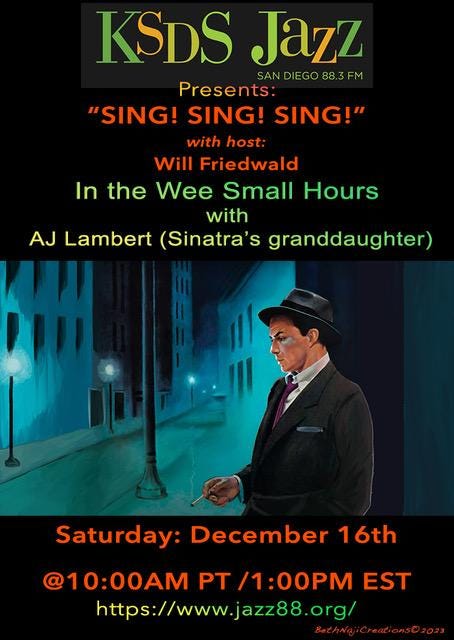

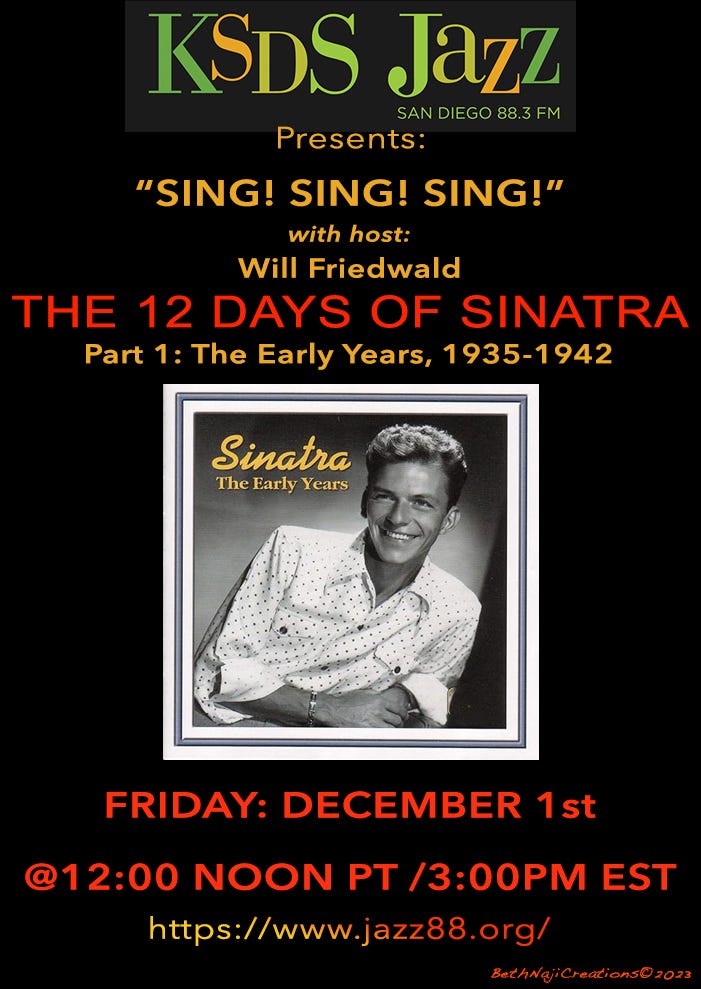
Asking as a historical architecture fan: does the Paramount still exist in its original form?